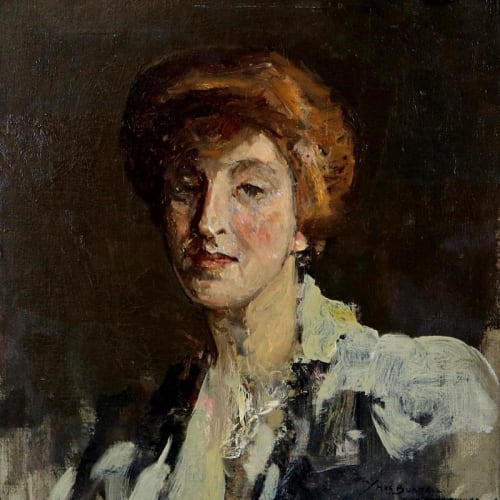Sir John Lavery NEAC KBE RA RSA RHA (20 March 1856 – 10 January 1941) was an Irish painter best known for his portraits and wartime depictions. He was elected a member of the New English Art Club in 1886.
Belfast-born Lavery attended Haldane Academy in Glasgow in the 1870s. In 1878, he set up his own studio which was razed in a fire in the following year. With a £300 insurance pay-out, he spent a year studying at Heatherley's School in London. Lavery continued his studies at the Académie Julian in Paris in the early 1880s.
He returned to Glasgow and was associated with the Glasgow School. In 1888, he was commissioned to paint the state visit of Queen Victoria to the Glasgow International Exhibition. This launched his career as a society painter, and he moved to London soon after. In London, he became friendly with James McNeill Whistler and was clearly influenced by him.
Career
Like William Orpen, Lavery was appointed an official artist in the First World War. Ill health, however, prevented him from travelling to the Western Front. A serious car crash during a Zeppelin bombing raid also kept him from fulfilling this role as a war artist.
He remained in Britain and mostly painted boats, aeroplanes and airships. During the war years, he was a close friend of the Asquith family and spent time with them at their Sutton Courtenay Thames-side residence, painting their portraits and idyllic pictures like Summer on the River.
After the war, he was knighted, and in 1921, he was elected to the Royal Academy. During this time, he and his wife Hazel were tangentially involved in the Irish War of Independence and the Irish Civil War. They gave the use of their London home to the Irish negotiators during the negotiations leading to the Anglo-Irish Treaty. After Michael Collins was assassinated, Lavery painted Michael Collins, Love of Ireland, now in the Hugh Lane Municipal Gallery.
In 1929, Lavery made substantial donations of his work to both The Ulster Museum and the Hugh Lane Municipal Gallery, and in the 1930s, he returned to Ireland. He received honorary degrees from the University of Dublin and Queen's University Belfast. He was also made a freeman of both Dublin and Belfast. A long-standing member of Glasgow Art Club, Lavery exhibited at the club's annual exhibitions, including its exhibition in 1939 in which his The Lake at Ranelagh was included.
Personal Life
Lavery's first wife, Kathleen MacDermott, whom he married in 1889, died of tuberculosis in 1891, shortly after the birth of their daughter, Eileen. In 1909, Lavery remarried to Hazel Martyn (1886–1935), an Irish-American known for her beauty and poise. Hazel Lavery was depicted in more than 400 of her husband's paintings. The sumptuous The Artist's Studio: Lady Lavery with her Daughter Alice and step-daughter Eileen, currently is in the National Gallery of Ireland.
Hazel Lavery modelled for the allegorical figure of Ireland he painted on commission from the Irish government, reproduced on Irish banknotes from 1928 until 1975 and then as a watermark until the introduction of the Euro in 2002.
Sir John Lavery died in Rossenarra House, Kilmoganny, Co. Kilkenny on 10 January 1941, aged 84, from natural causes, and was interred in Putney Vale Cemetery.
This is an edited version of John Lavery's Wikipedia biography.
You can also view hundreds of his artworks on his ArtUK website page.
Header image: Sir John Lavery, The Opening of the Modern Foreign and Sargent Galleries at the Tate Gallery, 26 June 1926, exhibited 1929. Creative Commons CC-BY-NC-ND

